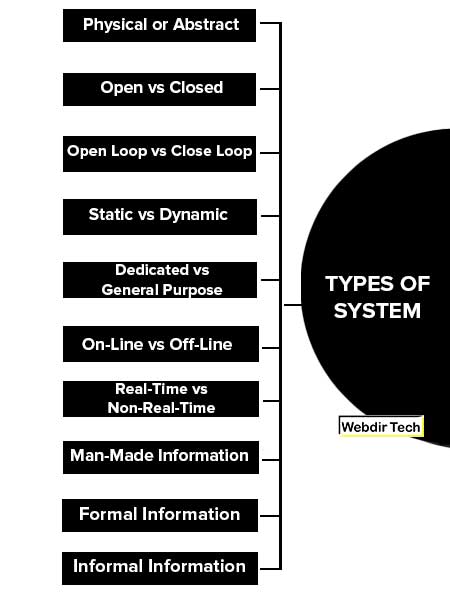Types of System
These are the different types of systems and their behavior:
- Physical or Abstract System
- Open vs Closed System
- Open Loop System vs Close Loop System
- Static vs Dynamic Systems
- Dedicated vs General Purpose Systems
- On-Line vs Off-Line System
- Real-Time vs Non-Real-Time Systems
- Man-Made Information System
- Formal Information Systems
- Informal Information Systems
- Computer Based Information
- Information System

Physical or Abstract System
Physical systems are tangible entities that we can feel and touch. These may be static or dynamic in nature. For example, take a computer center. Desks and chairs are the static parts, which assist in the working of the center.
Static parts don’t change. Dynamic systems are constantly changing. Computer systems are dynamic systems. Programs, data, and applications can change according to the user’s needs. Abstract systems are conceptual. These are not physical entities. They may be formulas, representations, or models of a real system.
Open vs Closed System
Systems interact with their environment to achieve their targets. Things that are not part of the system are environmental elements for the system. Depending upon the interaction with the environment, systems can be divided into two categories, open and closed.
Open systems: Systems that interact with their environment. Practically most of the systems are open systems. An open system has many interfaces with its environment. It can also adapt to changing environmental conditions. It can receive inputs from and delivers output to the outside of the system. An information system is an example of this category.
Closed systems: Systems that don’t interact with their environment. Closed systems exist in concept only.
Open Loop System vs Close Loop System
An Open-loop system, also referred to as a non-feedback system, is a type of continuous system in which the output has no influence or effect on the action of the input signal. In other words, in an open-loop system, the output is neither measured nor “fed back” for comparison with the input.
Therefore, an open-loop system is expected to faithfully follow its input command or set point regardless of the final result. Also, an open-loop system has no knowledge of the output condition so cannot self-correct any errors it could make when the preset value drifts, even if this results in large deviations from the preset value.
A Closed-loop System, also known as a feedback system is a system that uses the concept of an open loop system as its forward path but has one or more feedback loops (hence its name) or paths between its output and its input.
The reference to “feedback”, simply means that some portion of the output is returned “back” to the input to form part of the excitation of the system. Closed-loop systems are designed to automatically achieve and maintain the desired output condition by comparing it with the actual condition.
It does this by generating an error signal which is the difference between the output and the reference input. In other words, a “closed-loop system” is a fully automatic system in which its control action is dependent on the output in some way.
Static vs Dynamic Systems
Dynamic System: A dynamic system is a system that is constantly changing, like the human body system. A static system is a system in which there is no change, like the solar system. Dynamic systems tend to become static or attain a state of equilibrium.
For example, if a car is assumed to be a dynamic system, then it requires fuel to continue moving forward or else it would come to a stop and become static. Simply static systems are memoryless systems example a circuit of battery and resister.
Static Systems: Static systems output only depends on the present value of the input. Whereas dynamic systems have memory capability for example RLC circuits in which capacitors may have some initial value or flip-flops. Dynamic Systems’ output depends upon future and past values.
Dedicated vs General Purpose Systems
General Purpose Systems: General purpose systems can perform different types of tasks. A personal computer is a good example of a general-purpose computer.
Dedicated Purpose Systems: A dedicated (special purpose) system is built to handle a specific task, it can perform that task only and no other. Thus we can find a variety of dedicated systems performing a wide variety of tasks For example a payroll management system, or ATM.
On-Line vs Off-Line System
When a system is in the online mode of operation, it is performing operational functions. It is interfacing with other components, peripherals, display systems, and communication systems to perform many tasks.
The type of task the system will use online will depend on the platform of the system (tactical, tactical support, and non-tactical). A system may perform the following types of operations in the online mode:
- Operational
- Maintenance
In the offline mode of operation, a system is limited to performing maintenance. The system can be either powered or unpowered depending on the maintenance you are performing.
The system is limited to interfacing with only a single system, such as a display system or a peripheral system, to perform controlled tests or a diagnostic test itself. In this mode, some systems cannot only operate in the run mode but other detailed steps such as instruction mode and sequence mode. These modes are quite useful for troubleshooting malfunctions that can’t be isolated using diagnostics or self-tests.
Real-Time vs Non-Real-Time Systems
Real-Time Systems: Real-time systems are classified as hard or soft real-time systems. Hard real-time systems have very strict time constraints, in which missing the specified deadline is unacceptable. The system must be designed to guarantee all time constraints. Every resource management system such as the scheduler, input–output (I/O) manager, and communications, must work in the correct order to meet the specified time constraints.
Military applications and space missions are typical instances of hard real-time systems. Some applications with real-time requirements include telecom switching, car navigation, medical instruments with critical time constraints, rocket and satellite control, aircraft control and navigation, industrial automation and control, and robotics.
Soft real-time systems also have time constraints; however, missing some deadlines may not lead to catastrophic failure of the system. Thus, soft real-time systems are similar to hard real-time systems in their infrastructure requirements, but not every time constraint needs to be met.
In other words, some time constraints are not strict, but they are nonetheless important. A soft real-time system is not equivalent to a non-real-time system, because the goal of the system is still to meet as many deadlines as possible. A system in which there is no deadline defined is called a non-real-time system. The non-real-time system cannot guarantee a response time.
Man-Made Information System
The main purpose of information systems is to manage data for a particular organization. Maintaining files, and producing information and reports are a few functions. An information system produces customized information depending on the needs of the organization. These are usually formal, informal, and computer-based.
Formal Information Systems
It deals with the flow of information from top management to lower management. Information flows in the form of memos, instructions, etc. But feedback can be given from lower authorities to top management.
Informal Information Systems
Informal systems are employee based. These are made to solve day-to-day work-related problems. Computer-Based Information Systems: This class of systems depends on the use of computers for managing business applications.
Computer Based Information
System A system of one or more computers and associated software with common storage is called a system. A computer is a programmable machine that receives input, stores and manipulates data, and provides output in a useful format.
The computer elements described thus far are known as “hardware.” A computer system has three parts: the hardware, the software, and the people who make it work.
Information System
An information system (IS) is any combination of information technology and people’s activities using that technology to support operations, management, and decision-making. Information system deals with the data of the organizations.
The purposes of an Information system are to process input, maintain data, produce reports, handle queries, handle online transactions, generate reports, and other output. These maintain huge databases, handle hundreds of queries, etc.
The transformation of data into information is the primary function of the information system. Information systems differ in their business needs. Also depending on different levels in organization information systems differ.
Three major types of information systems are:
- Transaction Processing Systems
- Management Information Systems
- Decision Support Systems
Transaction Processing Systems
TPS processes business transactions of the organization. The transaction can be any activity of the organization. Transactions differ from organization to organization. For example, take a railway reservation system. Booking, canceling, etc are all transactions. Any query made to it is a transaction.
However, there are some transactions, which are common to almost all organizations. Like employee new employees, maintaining their leave status, maintaining employee accounts, etc.
This provides high speed and accurate processing of record keeping of basic operational processes. These include calculation, storage, and retrieval. Transaction processing systems provide speed and accuracy and can be programmed to follow the routine and functions of the organization.
Management Information Systems
These systems assist lower management in problem-solving and making decisions. They use the results of transaction processing and some other information also. It is a set of information processing functions.
It should handle queries as quickly as they arrive. An important element of MIS is the database. A database is a non-redundant collection of interrelated data items that can be processed through application programs and available to many users.
Decision Support Systems
These systems assist higher management to make long-term decisions. These types of systems handle unstructured or semi-structured decisions. A decision is considered unstructured if there are no clear procedures for making the decision and if not all the factors to be considered in the decision can be readily identified in advance.
Gorry and Morton Coined the term decision support system (DSS). The origin of the term is simple:
- Decision: Emphasizes decision-making in problem situations, not information processing, retrieval, or reporting.
- Support: Requires computer-aided decision situations with enough “structure” to permit computer support.
- System: Accentuates the integrated nature of problem-solving, suggesting a combined “man”, machine, and decision environment.
These are not recurring. Some recur infrequently or occur only once. A decision support system must very flexible. The user should be able to produce customized reports by giving particular data and formats specific to particular situations.
FAQs Related to the Types of System
What are the types of systems?
The following are the types of systems:
1. Physical or Abstract System
2. Open vs Closed System
3. Open Loop System vs Close Loop System
4. Static vs Dynamic Systems
5. Dedicated vs General Purpose Systems
6. On-Line vs Off-Line System
7. Real-Time vs Non-Real-Time Systems
8. Man-Made Information System
9. Formal Information Systems
10. Informal Information Systems
11. Computer-Based Information
12. Information System.
